“Tucked-In: Resilience in Small Moments” by Elizabeth Fram
August 26, 2022
It’s no surprise that responses to Covid-19 have been as numerous and diverse as we are individual. Interestingly, many artists I’ve spoken to have found a silver lining in the hours and days of uninterrupted solitude the pandemic gave them to work. I count myself among that fortunate contingent.
More than 15 months ago, SDA members Dianne Shullenberger, Leslie Roth and I began to scheme about putting together an exhibition of the work we’d been making in the year after lock-down began. As the months of Covid-19 wore on, a frequent topic of discussion between us had been acknowledging that our art practices were key to getting us through this uncharted period with our sanity intact.
It wasn’t just the fact that going to the studio offered regularity and purpose—although it did, and that in itself was a huge boon—but our art-making also became an outlet that provided solace. Our practices became something of a protective shield of normalcy against the chaos brewing outside our studios where everything seemed so topsy-turvy and out of control. The end product of those discussions is Tucked In: Resilience in Small Moments.
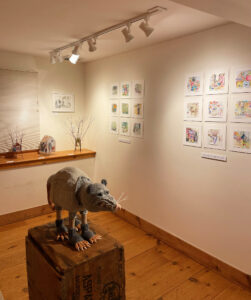
Tucked-In: Resilience in Small Moments (installation) at Emile A. Gruppe Gallery (Leslie Roth foreground, Dianne Shullenberger on right wall, Elizabeth Fram on back shelf and wall), Photo: Elizabeth Fram.
This exhibit is a feel-good manifestation of how we each, in our own way, found and tapped into pockets of positivity in the face of a global pandemic—through our homes, our gardens, our friends and our wildlife neighbors. Even more importantly, the common denominator for making those discoveries was our art.
Many experienced changes in their art practice during the pandemic. Dianne Shullenberger took a conscious break from her usual textile collages yet, always true to her love of landscape, she began to create small ink drawings with watercolor washes, capturing quiet views during lock-down. Whether portraying vignettes of personal treasures within her studio, hidden corners of her garden during the warmer months, or the view through her studio window once everything was covered with snow, Dianne leaned on these paintings and her personal environment as a calming avenue toward joy and comfort in the face of uncertainty.
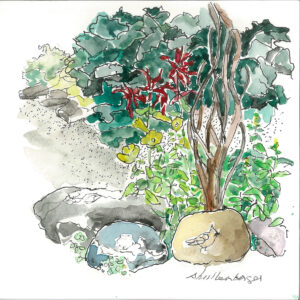
Dianne Shullenberger, Cardinal Sculpture, 2020. Watercolor and ink on paper, 6 x 6 inches. Photo by the artist.
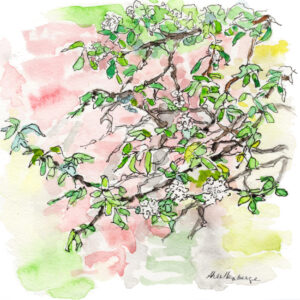
Dianne Shullenberger, Overhanging, 2021. Watercolor and ink on paper, 6 x 6 inches. Photo by the artist.
Leslie Roth embraced the full range of her lockdown experience, acknowledging the shift between intervals of turmoil and peace by channeling that duality into her practice. Many of her mixed media sculptures celebrate animal inhabitants of the woods and meadows surrounding her home in Vermont. Other pieces follow her imagination; she sculpts and knits fantastical creatures that are simultaneously humorous and subtly unnerving. Each real or imagined figure is made from foam board, canvas, wood, wire, and polymer clay paired with knitted hands, feet, and a head that brims with expression. Leslie freely and delightfully anthropomorphizes her creatures in an exploration of both emotion and narrative.
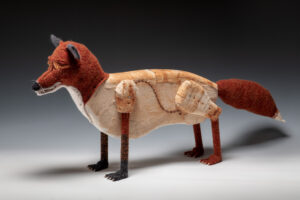
Leslie Roth, The Sweetest Grape, 2021. Knitted yarn, carved foam board, dyed canvas, wood, wire, upholstery tacks, staples, polyester stuffing, polymer clay, 21 x 9 x 47 inches. Photo: Paul Rogers.
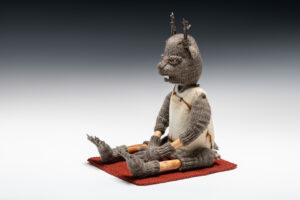
Leslie Roth, Binge Watching, 2021. Knitted yarn, carved foam board, dyed canvas, wood, wire, upholstery tacks, staples, polyester stuffing, polymer clay, 13 x 8 x 13 inches. Photo: Paul Rogers.
For my own part, once Covid-19 took hold I began to make 3D houses as a means for translating the wide scope of emotions and circumstances we suddenly faced. The iconic house form serves as an apt canvas for contemplating the commonality of sheltering-in-place, the diversity of challenges that presented themselves and varied ways of coping. Each house is faced with shibori-dyed silk and embroidery, typical of my 2D work. I incorporated branches foraged from my yard and woods to highlight the literal and figurative support nature provided, especially during those scary early months of isolation.
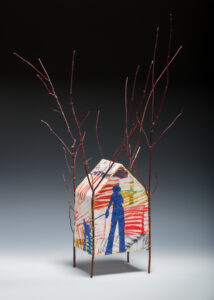
Elizabeth Fram, Cultivating An Oasis, 2020. Wrapped-resist dyed raw silk and Peltex, embroidered and hand-stitched with silk and cotton thread, foraged branches, 27 x 15 x 16 inches. Photo: Paul Rogers.
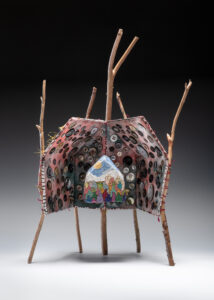
Elizabeth Fram, When We Emerge, 2021. Stitched-resist dyed raw silk, Peltex, embroidered and hand-stitched with silk, cotton and metallic thread, buttons, foraged branches, 21 x 12 x 10 inches. Photo: Paul Rogers.
Our goal with this exhibition is to share moments of hope and resilience found within the act of a regular studio practice. In the face of all the despair that has dominated the past couple of years, we view this show as an opportunity to offer some good news.
Tucked In: Resilience in Small Moments
- Leslie Roth | Dianne Shullenberger | Elizabeth Fram
- Emile A. Gruppe Gallery
- 22 Barber Farm Road, Jericho, Vermont, US 05465
- May 1–June 19, 2022
–Elizabeth Fram’s practice is a balance between drawing and hand-worked textile processes that combine resist dye techniques with embroidered imagery. She exhibits nationally and internationally, including the 2019 Rijswijk Textile Biennial in The Netherlands and the 2021 SDA International Exhibition in Print. Her studio is in Waterbury Center, Vermont.

